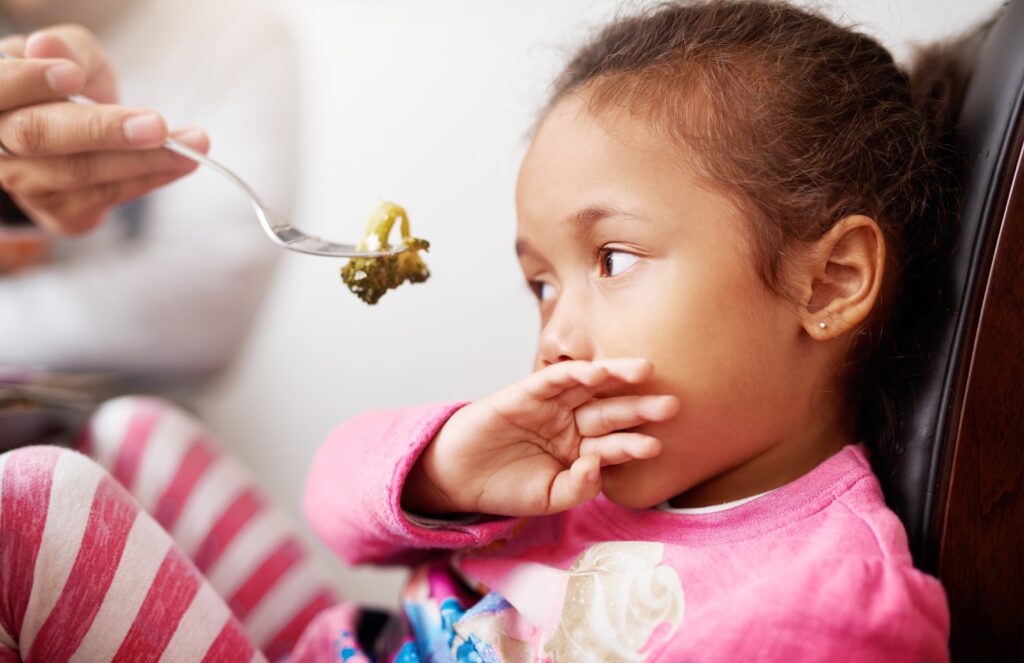Monthly Email List
Get Our Love Letters
Nutrition updates and reflections that are child-centered, pro-lifestyle and sensitive to unique needs.
Parent support in fuzzy slippers!
Sign Up Now
The ups and downs of food refusals in a situation where a parent suspects or knows there is already a lack of nutrients can cause parents significant stress! Whether you call it ‘driving you nuts’ or are starting to see it as a deeper, trauma-related pattern or stressor in your life is up to you and your lived experience. Here are some foundational ideas and tools to create a healthy response (vs. frenzied reaction) for yourself and your child:
Co-regulation is the ability to regulate emotions and behaviors to soothe and manage stressing internal sensory input or external situations, with the support and direction of a connecting individual. Children are still learning to self-regulate, so a great way for parents to respond to a child’s distress during mealtime is to focus first on regulating themselves, using positive self-talk, mindfulness tools, or calming techniques. When caregivers respond from this place, flexibility and creativity can emerge, increasing the chance for a more positive experience on both sides.
Though refusing meals and snacks may feel like the ultimate act of rebellion, consider your child’s refusal in the light of interdependence, or the need we have for one another. On one level or another, your child understands that food is needed in order to survive. If the food you are offering appears inaccessible to them for any reason, they need to form a communication and depend on you to interpret their communication in order for them to be able to access the food they need to survive. The hard part to accept is this is subjective for each child and varies day to day- it could be a speck of brown on their fruit one day, on another day, they may eat it with no problem. This inability to access food could be obvious, like they don’t have a gross or fine motor skill to eat a particular food or texture. Or, it could be less obvious, like an internal physical or sensory related issue that hasn’t yet been discovered or considered. When they refuse, they are communicating. There is a myth that children need to be independent with their eating. Children aren’t a ‘burden’ or ‘inferior’ because they need help to find foods that meet their needs.
If you start to look at all meals and snacks your child is refusing as communication, it can remove some of the sting and resentment, and open up the experience to becoming curious. Take a curious look at your child’s last food refusal by first, regaining your calm and pausing for some deep, even breaths.
Key phrases include:
When to stay silent: Many parents tend to talk to or direct children in their eating experience more than is necessary, which can stress the parent-child feeding relationship or lead to a child not feeling they can express their needs or desires around food. Building in some silent time at meals or a calming steady beat of music in the background is a great way to balance all the sensory input going on at meal and snack time. Staying silent while your child engages with or eats a new food can allow them to experience it without interference. Kids sometimes feel food praise as pressure to continue eating or need to eat it the next time it’s offered. They are already in their curious zone if they are trying new food, so that is a win you can celebrate as a parent, regardless of how much of it they eat!
When you are staying silent, you can also instead focus your communication around non-verbal cues and ways you are communicating: maybe you can alter the serving size for them, maybe they need decreased sensory stimulation from the dog in the room, maybe they need to eat in a different location that better matches the current energy level or emotions, or maybe you can alter how close or far away you are from your child to increase their comfort level, or the level and tone of your voice. This also may be something you are doing to make the situation easier to manage for yourself.
If you want to ask them a question about their experience, start with the words, ‘I am curious…?’ and ask open-ended questions like: ‘What’s it like?’, ‘What’s the sound of this food?’, ‘How does this food feel?’
Adults and kids alike need routines to create a deep sense of felt safety. From this place, we can learn new things and fully express ourselves and our potential. When we optimize and personalize our routines around food, we send all our senses a safety signal that we can eat our fill of the foods we need.
If you would like assistance on routines and responses that work best for you and your child at mealtimes, please get in touch anytime or sign up for our free newsletter to learn more about the Attune2Food approach and services.
References:
Kinne, J. (2022, July 13). Co-regulation. The OT Toolbox
Theottoolbox.com
Nutrition updates and reflections that are child-centered, pro-lifestyle and sensitive to unique needs.
Parent support in fuzzy slippers!
Sign Up NowProviding infant, child, adolescent, teen and family-centered nutrition counseling in Arizona, California, Colorado, Maryland, Michigan, Nevada, New Hampshire, New York, Oregon, Vermont and Virginia.
Providing nutrition and feeding coaching services to parents and caregivers across the US.